Yes, you can legally fly a drone in Stanley Park, but it’s no walk in the woods! Pilots must register their drone (if it’s over 250 grams), hold an Advanced Pilot Certificate, and get explicit permission from park authorities—plus airspace clearance using the Nav Drone app. From swooping helicopters to nesting herons, risks and fines can pile up faster than a flock of seagulls at lunchtime. Want details on getting it right and avoiding wildlife chaos? Stick around!
Key Takeaways
- Recreational drone flights in Stanley Park are not outright banned, but strict regulations and permissions apply.
- Advanced certification and prior permission from park authorities are required due to controlled airspace and nearby helicopter traffic.
- Drones over 250 grams must be registered, display an ID number, and operators need the appropriate Transport Canada license.
- Airspace authorization via the Nav Drone app is mandatory before flying in Stanley Park.
- Environmental concerns, safety risks, and local bylaw changes may further restrict or soon prohibit drone use in the park.
Understanding the Legal Status of Drones in Stanley Park
Curious about flying your drone in Stanley Park? The legal debates around this popular Vancouver landmark are buzzing almost as much as the drones themselves! While statute analysis shows there’s no specific bylaw currently banning recreational drone flights in Stanley Park, the situation is far from simple. Authorities anticipate tighter rules, especially with low-flying helicopters, float planes, and protected wildlife habitats nearby. Advanced certification and prior permission are essential for those hoping to fly here, but don’t expect an easy process. Discussions hint at upcoming bans or stricter regulations. Unlike national parks, which have clear no-drone rules, Stanley Park’s legal status remains a little murky—think of it as flying through a fog bank, with new rules possibly just around the corner! Additionally, compliance with Remote ID capabilities may soon become mandatory to meet evolving regulatory standards.
Navigating Canadian Drone Regulations
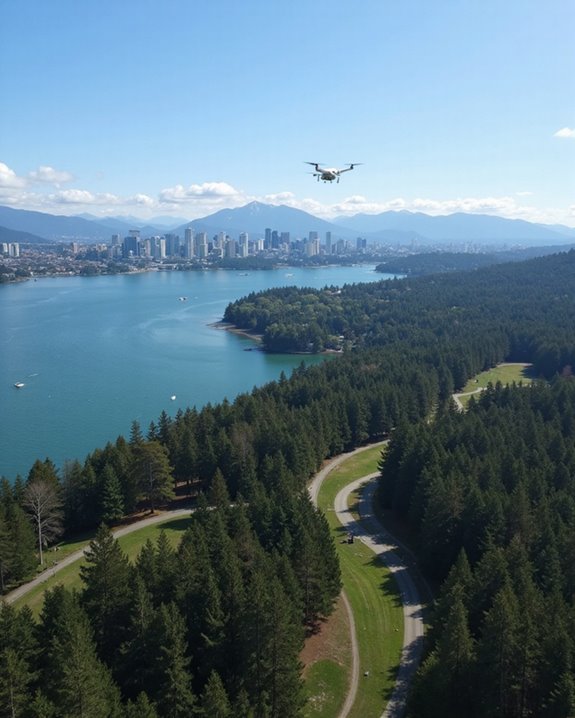
Flying a drone in Stanley Park might sound like a breeze—just grab your gear and go, right? Not so fast! Canada is serious about drones, and the rules are no joke. Every drone between 250 grams and 25 kilograms must be registered, with the number proudly displayed—like a license plate for your flying gadget. Pilots need certification: basic operations require passing the Small Basic Exam, while advanced uses need the Small Advanced Exam and a Flight Review. Canada’s regulations now allow some beyond visual line-of-sight (BVLOS) flights, pushing for international alignment and supporting economic growth in the drone sector. New technical standards, updated exams, and special rules for medium drones make compliance an adventure—just not the spontaneous kind! Using a drone with built-in Remote ID can simplify adherence to these regulations and enhance safety during flights.
Required Permissions and How to Obtain Them
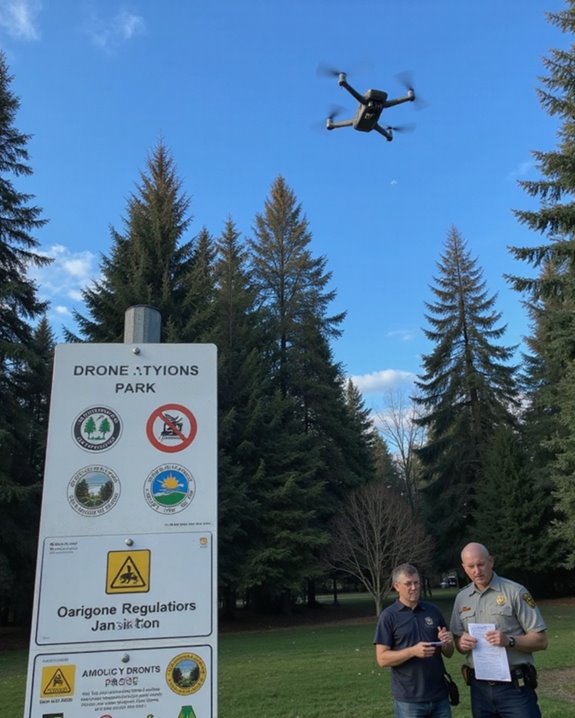
Before a drone ever lifts off in Stanley Park, there’s a checklist that’s more involved than packing a picnic lunch! First, drone pilots must contact park authorities to get official property permission, which often comes with permit fees that can vary depending on the type of flight—commercial, research, or recreational. Next, Transport Canada requires pilots to register drones over 250 grams and hold the right license, and sometimes, advanced certifications are needed for certain areas. Airspace authorization is usually managed through the Nav Drone app, especially if flying near controlled airspace. Pilots should also be prepared for a renewal process, as permissions and certifications aren’t always permanent. Finally, keeping up with local bylaws and double-checking the renewal process will help avoid any legal headaches! Additionally, using a FAA Compliant Remote ID Module is essential for broadcasting drone identification as required by law.
Safety Risks Unique to Stanley Park
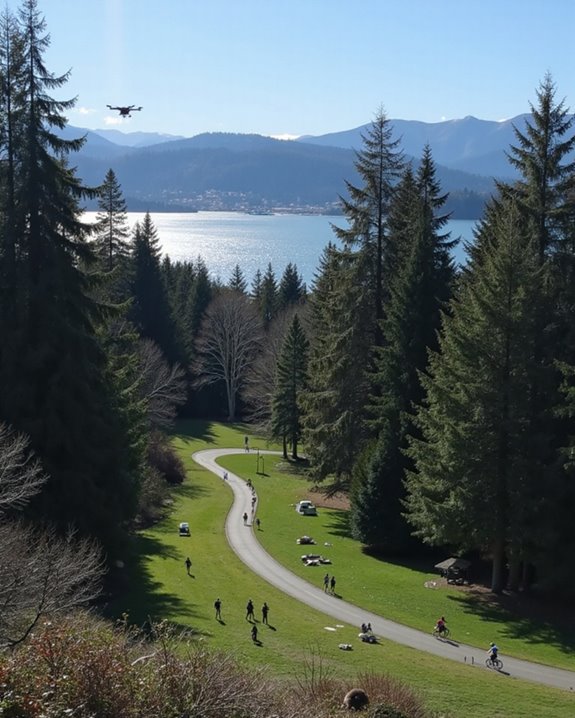
Getting the right paperwork sorted is just the beginning—Stanley Park brings its own set of wild cards when it comes to flying drones! Dense trees, winding trails, and unpredictable weather make accidental collisions a real concern. Imagine your drone weaving through the famous Seawall, only to meet a surprise kite or dodge a wayward balloon at Lost Lagoon—talk about stressful piloting! Battery failure is another major headache; if your drone’s power drops mid-flight, it could crash into the park’s historical totem poles or land in a duck pond. The park’s unique mix of busy paths, tall structures, and hidden power lines keeps drone operators on high alert. Even with experience, Stanley Park’s obstacles can quickly turn a nice day out into a costly mishap.
Environmental and Wildlife Protection Concerns
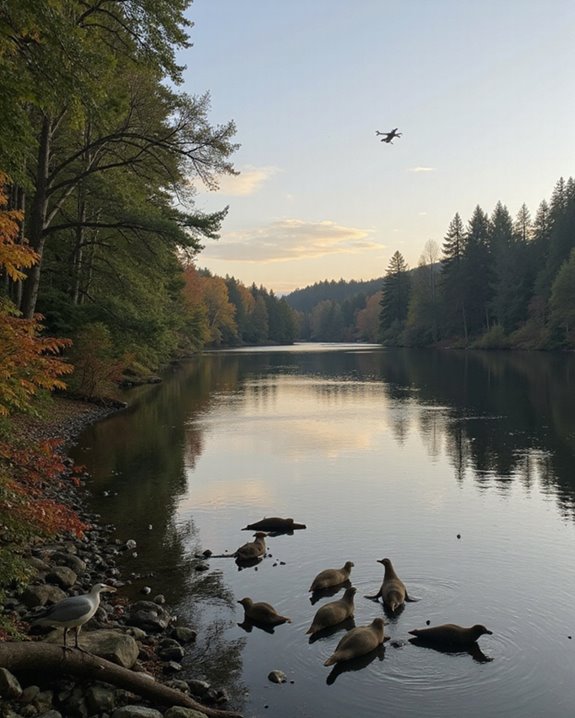
Ever wonder what’s really at stake when a drone zips through Stanley Park’s towering cedars or swoops over Beaver Lake? It’s not just about cool aerial photos—drones can actually cause real Habitat Disruption. Imagine nesting herons startled mid-lunch or ducks abandoning their cozy reed beds due to sudden buzzing overhead. That’s Wildlife Stress in action! The noise and visual presence of drones can spook animals, disrupt migratory birds, or even mess with predator-prey dynamics. These tiny flying machines may seem harmless, but they can throw off delicate ecosystem balances, damage fragile plants, and make life tough for conservation teams. So, while the urge to fly is real, protecting Stanley Park’s natural wonders is a much bigger deal than you might think!
Step-by-Step Guide for Lawful Drone Operations
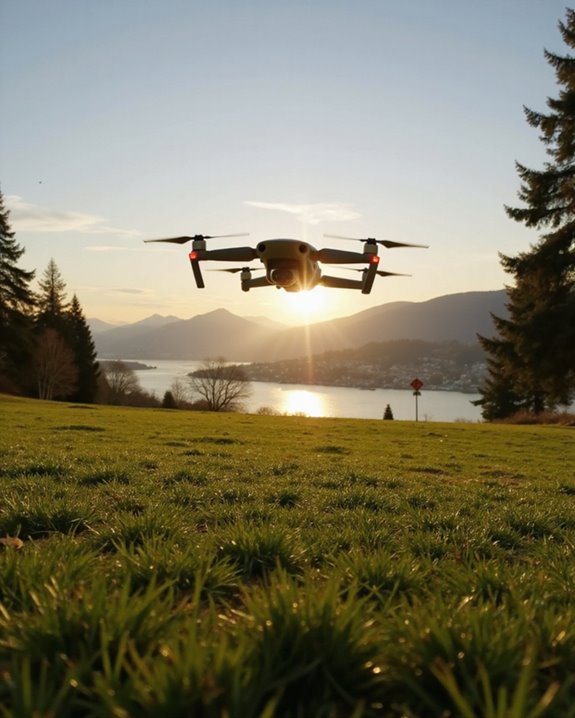
One important thing to know before launching a drone in Stanley Park is that it takes more than just charging your batteries and picking a sunny day. First, check Transport Canada’s rules—Stanley Park sits in controlled airspace, so you’ll need proper authorization before takeoff. Next, double-check your Equipment Setup: is your drone registered, and do you have your pilot certification handy? A pre-flight inspection is a must—nobody wants a surprise midair crash! Log Keeping isn’t just boring paperwork; it’s required and could save you from a $15,000 fine if questioned. Make detailed notes about each flight: date, time, location, and any issues. Finally, always monitor for emergency updates, stay clear of wildlife, and remember—safe flying keeps everyone (and your wallet) happy!
Comparing Drone Rules Across Vancouver Parks
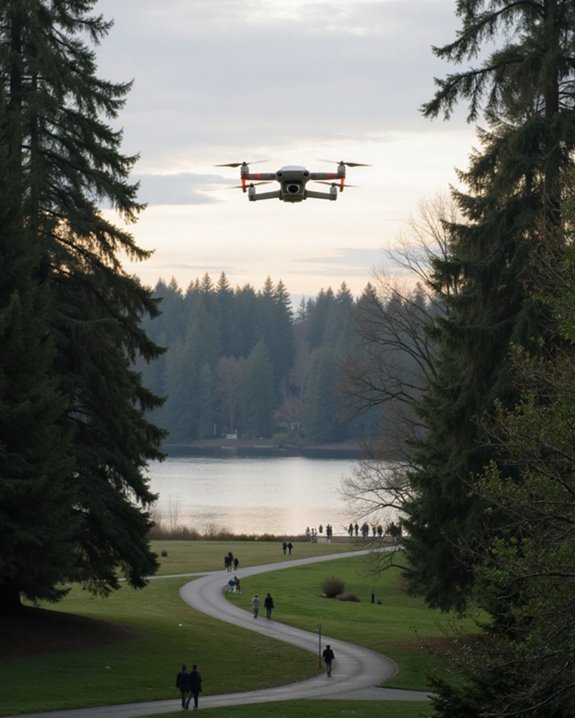
Before you send your drone skyward, it helps to know the ground rules—and they’re not the same everywhere! Park comparisons in Vancouver show a patchwork of regulations. Stanley Park, for example, sits in controlled airspace, making casual drone flights almost impossible unless you’ve got advanced certification. Other city parks, like Queen Elizabeth Park and VanDusen Botanical Garden, aren’t much friendlier—they’re no-fly zones due to crowds and sensitive gardens. Rule evolution across Vancouver has made drone use trickier, reflecting concerns about privacy, wildlife, and safety. Provincial parks often require permits or ban drones altogether, while national parks enforce strict federal laws—don’t even think about sneaking a flight there! If you’re searching for drone-friendly turf, smaller, quieter parks might be your best hope.
Frequently Asked Questions
What Types of Drones Are Recommended for Use in Urban Parks Like Stanley Park?
When considering drones for use in urban parks, models featuring compact design, strong wind resistance, and advanced flight stability are recommended. Gimbal-stabilized cameras, autonomous obstacle avoidance, and lightweight construction further enhance safety and performance in such settings.
Are There Specific Drone Models Banned From Use in Vancouver Parks?
The question of banned models lingers; however, no specific drone models are explicitly banned from use in Vancouver parks. Exemption reasons focus on compliance with Transport Canada regulations, operational safety, and environmental considerations, rather than particular drone types.
How Can I Insure My Drone for Flights in Public Spaces?
Obtaining drone insurance for public flights involves contacting insurance providers, evaluating policy costs, and selecting appropriate coverage. Applicants should evaluate liability and equipment needs, review exclusions, and guarantee compliance with regulations to maintain valid coverage during operations.
What Should I Do if My Drone Crashes in a Restricted Area?
When an unexpected landing occurs in a restricted area, crash procedures recommend securing the site, reporting to authorities if required, and following retrieval steps carefully. Responsible drone operators prioritize regulatory compliance, environmental consideration, and safe recovery practices.
Are There Local Drone Clubs or Communities in Vancouver for Hobbyists?
Local drone clubs and communities in Vancouver offer hobby networking opportunities through regular club events, workshops, and online forums. These organizations connect enthusiasts, provide training, and foster compliance with regulations, supporting both recreational and professional drone pilots.





